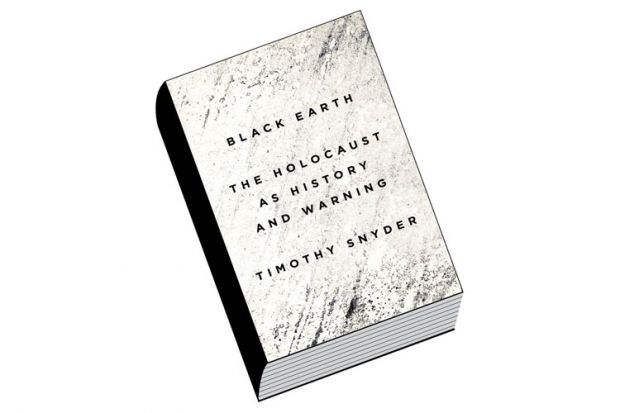In this sequel to Bloodlands, his acclaimed 2010 study of the deadly European conflicts in the age of Stalin and Hitler, Timothy Snyder focuses on the Holocaust and reminds us that most of the killing occurred on the “doubly occupied lands” initially taken by the Red Army in 1939, and then captured by the Wehrmacht in 1941.
To begin with, the author quite rightly takes a contrary stance to those commentators who, since the 1920s, have labelled Hitler a mere opportunist and dismissed his ideological fixations on anti-Semitism, anti-Bolshevism and Lebensraum as little more than “propaganda slogans”. It now seems that even today some serious historians still write off these “slogans” as “ideological metaphors” and thus fail to grasp that, for Hitler, these ideas were firm statements of intent. By contrast, Snyder discerns a “hidden coherence” in Nazi ideology, for which the law of racial struggle was “as certain as the law of gravity”.
However, in attempting to make sense of Hitler’s worldview, the author synthesises evidence taken from the years 1920 to 1945, a method that makes it difficult to see the ideology’s evolution. More troublingly, Snyder contends that the Führer “was not even a German nationalist”, which flies in the face of the documentary evidence. A glance at photographs of the beaming leader among swooning crowds during the 1930s conveys the overwhelming impression of a loving relationship that grew strained as defeat loomed in 1944. Hitler then occasionally went on rants against the “unworthy” people and renounced his military leaders, even paladins such as SS leader Heinrich Himmler and Hermann Göring. Yet for perspective, we need to recall the leader’s valorisation, up to 1944, of Germans and their contributions in history.
Notwithstanding Snyder’s assertions to the contrary, Hitler’s Pan-Germanic dream was an expansive variety of nationalism, one that into 1942 called for living space in Russia up to the Ural Mountains, approximately 2,000 miles east of Moscow. Autobahns would link German “strong points”, cities hermetically isolated from subjugated populations, with the monumental capital renamed Germania, to reflect one nation’s domination and greatness. The conquerors would eliminate, enslave or drive out native inhabitants and bring in racially acceptable re-settlers, so that in two or three generations, the former Russian expanse would be completely German. Although Snyder, like other historians, underlines Hitler’s lust for colonies, he is mistaken to claim that the Führer dreamed of something like America with its vast spaces and native people. To the contrary, the evidence suggests Hitler often spoke privately of something like a fantasised version of British rule in India.
In any case, after Snyder’s initial exploration of Hitler’s eschatological worldview, the leader mostly fades into the background and we get a narrative of the Holocaust. When it comes to the decision to kill all the Jews, the evidence is inevitably circumstantial, although here Snyder adopts the thesis of a recent German account in claiming that a meeting with key Nazi leaders behind closed doors on 12 December 1941 represented “a turning point”. Allegedly it was then that the Führer “announced” his “intent to eliminate all Jews”, without ever issuing an “explicit order”. Most specialists, however, would select other turning points, particularly in October, when a whole confluence of decisions came together.
The most chilling thing, Snyder argues, was not the following of a mass murder plan, as there was none, but “the worldview in which individuals [presumably Jews] are defined as a supernatural collectivity such that their removal is seen as ethical and the method of removal makes no moral difference”.
Snyder may be right to insist that anti-Semitism is not enough to explain what happened, and it is certainly true that “the politics of mass killing was a joint creation” of the invaders and the occupied peoples. Even so, surely hatred of the Jews provided the key common denominator, variously mixed among perpetrators and collaborators, with other ideological convictions, religious beliefs, situational factors and material interests.
In the conclusion, we get to the “warning” signalled in the book’s subtitle, and yet Snyder does not explain in plain English exactly what the “lessons” of the Holocaust are. His opaque language makes it imprudent to issue “either/or” imperatives that “humanity” must learn from this specific historical experience, in order to cope with hypothetical, undefined crises that may arise from what he believes is the imminent onset of global warming.
Robert Gellately is Earl Ray Beck professor of history, Florida State University, and author, most recently, of Stalin’s Curse: Battling for Communism in War and Cold War (2013).
Black Earth: The Holocaust as History and Warning
By Timothy Snyder
Bodley Head, 480pp, £25.00
ISBN 9781847923493
Published 17 September 2015
Register to continue
Why register?
- Registration is free and only takes a moment
- Once registered, you can read 3 articles a month
- Sign up for our newsletter
Subscribe
Or subscribe for unlimited access to:
- Unlimited access to news, views, insights & reviews
- Digital editions
- Digital access to THE’s university and college rankings analysis
Already registered or a current subscriber? Login




